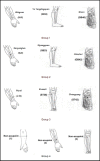A central analgesic mechanism of acupuncture for migraine: An ongoing functional MRI study
- PMID: 25206576
- PMCID: PMC4146023
- DOI: 10.3969/j.issn.1673-5374.2013.28.007
A central analgesic mechanism of acupuncture for migraine: An ongoing functional MRI study
Abstract
Shaoyang acupoints are the most frequently used in migraine treatment. However, the central analgesic mechanism remains poorly understood. Studies have demonstrated that single stimulus of the verum acupuncture in healthy subjects can induce significant connectivity or activity changes in pain-related central networks compared with sham acupuncture. However, these findings are not indicative of the central analgesic mechanism of acupuncture at Shaoyang acupoints. Thus, we recruited 100 migraine sufferers and randomly assigned them into five groups: Shaoyang uncommon acupoint, Shaoyang common acupoint, Yangming uncommon acupoint, non-acupoint control, and blank control groups. Subjects were subjected to evaluation of curative effects and functional MRI prior to and after 10 and 20 acupuncture treatments. All subjects were diagnosed by physicians and enrolled following clinical physical examination. Subjects were observed during 1-4 weeks after inclusion. At the fifth week, the first clinical evaluation and resting functional MRI were conducted. The Shaoyang mon acupoint, Shaoyang common acupoint, Yangming uncommon acupoint, and non-acupoint control grousp then were treated with acupuncture, five times per week, 20 times in total over 4 weeks. The second and third clinical evaluations and resting functional MRI screenings were conducted following 10 and 20 acupuncture treatments. The blank control group was observed during the 5 to 8 week period, followed by clinical evaluation and resting functional MRI. The aim of this study was to examine changes in brain functional activity and central networks in subjects with migraine undergoing acu-puncture at Shaoyang uncommon acupoints. This study provides a further explanation of the central analgesic mechanism by which acupuncture at Shaoyang acupoints treats migraine.
Keywords: acupuncture; acupuncture and moxibustion; analgesia; central response; continuous central activity; functional MRI; grants-supported paper; migraine; neural regeneration; neuroregeneration; sessions of acupuncture; study design.
Conflict of interest statement
Figures
References
-
- Wang SJ, Liu HC, Fuh JL, et al. Prevalence of headaches in a Chinese elderly population in Kinmen: age and gender effect and cross-cultural comparisons. Neurology. 1997;49(1):195–200. - PubMed
-
- Hagen K, Zwart JA, Vatten L, et al. Prevalence of migraine and non-migrainous headache-head-HUNT, a large population-based study. Cephalalgia. 2000;20(10):900–906. - PubMed
-
- Diamond S, Bigal ME, Silberstein S, et al. Patterns of diagnosis and acute and preventive treatment for migraine in the United States: results from the american migraine prevalence and prevention study. Headache. 2007;47(3):355–363. - PubMed
-
- Göbel H, Petersen-Braun M, Soyka D. The epidemiology of headache in Germany: a nationwide survey of a representative sample on the basis of the headache classification of the international headache society. Cephalalgia. 1994;14(2):97–106. - PubMed
-
- Ferrari MD. The economic burden of migraine to society. Pharmacoeconomics. 1998;13(6):667–676. - PubMed
LinkOut - more resources
Full Text Sources


